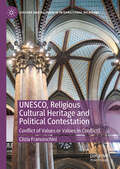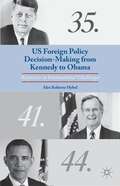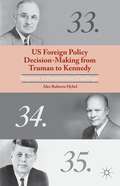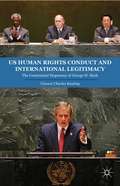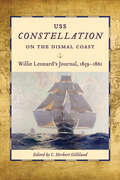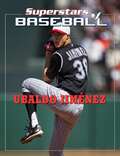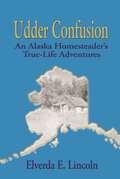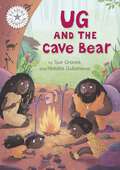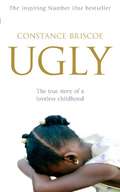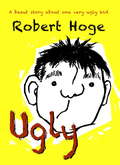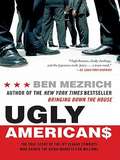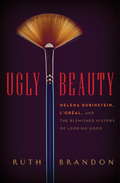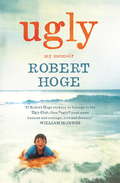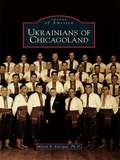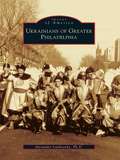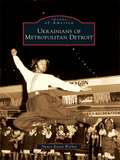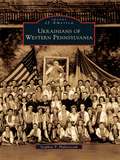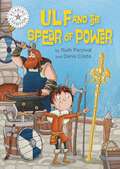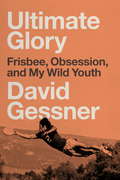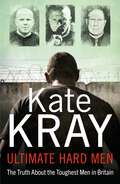- Table View
- List View
UNESCO, Religious Cultural Heritage and Political Contestation: Conflict of Values or Values in Conflict? (Culture and Religion in International Relations)
by Clizia FranceschiniThis book offers an innovative study of UNESCO's religious heritage and nomination mechanisms. In particular, it shows how these processes can easily become instruments of power politics, undermining the neutrality and impartiality of the nomination processes. This is particularly true where political contestation for the exercise of sovereign authority over the site is politically contested and the competing claims are primarily based on shared cultural and religious narratives, which both sides in the dispute use to assert their claims. In this respect, religious heritage, both in its tangible and intangible dimensions, is the subject of national and global decisions that have political, cultural and religious implications. Starting from this premise, the book aims to show that the global regulatory framework and institutional decisions in the field of religious heritage are not neutral, but are determined by political discourses and agendas of governments and UNESCO.
US Foreign Policy Decision-Making from Kennedy to Obama
by Alex Roberto HybelDuring the past fifty years, the United States has been involved in multiple wars. Alex Roberto Hybel's extensively documented book uses some of today's leading foreign policy decision-making models to analyze John F. Kennedy, Lyndon B. Johnson, Richard Nixon's distinct responses to the challenges emanating from Vietnam; George H. W. Bush's decision to defend Kuwait from the Iraqi occupation; George W. Bush's orders to invade Afghanistan and Iraq shortly after September 11, 2001; and Barack Obama's handling of perilous challenges in the nation's intervention in Afghanistan as he assumed the presidency. Throughout the book, Hybel meticulously explores each president's foreign policy decision-making process from the initial definition of the challenge to the moment the policy is formulated. Hybel pays special attention to each president's analytical process; the extent to which he relied on the counsel of his advisors; the mindsets that influenced his thinking and those of Washington's insiders; and the cognitive obstacles, if present, that afflicted his overall foreign policy decision-making process. Hybel concludes each analysis by identifying the model or models that best explains each president's approach to foreign policy decision-making and by assessing the quality of each president's approach to foreign policy formulation. His analyses provide in depth insights into to the way US leaders created foreign policies during unsettling periods.
US Foreign Policy Decision-Making from Truman to Kennedy
by Alex Roberto HybelThe book has three objectives: to expose students to the ways different US presidents handled major foreign policy making problems; to test the explanatory value of alternative decision-making models; And to reintroduce students to a wide range of critical US foreign policy issues.
US Human Rights Conduct and International Legitimacy
by Vincent Charles KeatingWas the Bush administration was successful in legitimating its preferences with habeas corpus, torture, and extraordinary rendition? As American transforms in the post-Bush era, scholars have begun to assess the post-9/11 period in American foreign and domestic policy, asking difficult questions regarding torture and human rights.
USS Constellation on the Dismal Coast: Willie Leonard's Journal, 1859–1861 (Studies in Maritime History)
by C. Herbert GillilandThis seaman’s journal recounts a twenty-month voyage from Boston to the African coast to intercept slave-trading vessels as America approach the Civil War.Today the twenty-gun sloop USS Constellation is a floating museum in Baltimore Harbor; in 1859 it was an emblem of the global power of the American sailing navy. William E. Leonard served aboard the Constellation during a crucial and eventful period, chronicling it all in this remarkable journal.Sailing from Boston, the Constellation, flagship of the US African Squadron, was charged with the interception and capture of slave-trading vessels illegally en route from Africa to the Americas. During the Constellation’s deployment, the squadron captured a record number of these ships, liberating their human cargo and holding the captains and crews for criminal prosecution. At the same time, tensions at home and in the squadron increased as the American Civil War approached and erupted in April 1861.Leonard recorded not only historic events but also fascinating details about his daily life as one of the nearly four-hundred-member crew. He saw himself as not just a diarist, but a reporter, making special efforts to seek out and record information about individual crewmen, shipboard practices, recreation and daily routine—from deck swabbing and standing watch to courts martial and dramatic performances by the Constellation Dramatic Society.
Ubaldo Jiménez (Superstars of Baseball)
by Tania RodriguezUbaldo Jiménez has become one of the most popular pitchers in Major League Baseball. Many fans believe he could become one of the all-time great pitchers. Jiménez hasn't been in baseball long, but he's already had an amazing career. He's played in the All-Star Game, pitched in the playoffs, won awards, and even pitched a no-hitter. Learn about Jiménez's journey from the Dominican Republic to the Major Leagues. Find out how his family played a part in making Jiménez the man he is today.
Uccidere il Prudente. Vita di Pericle, stratega di Atene.
by Borja Loma BarrieRomanzo storico. Biografia. Su Pericle, governante di Atene, costruttore del Partenone, di origine oligarchica ma avversario della sua classe. Storia della Grecia, di Sparta e di Atene. Le Guerre del Peloponneso. Le Guerre Persiane. Le riforme di Solone. L'ostinazione per la democrazia. L'ostilità e le lotte sociali tra ricchi e poveri. Gli ateniesi, rosi dai debiti, decidono di trasformarsi in schiavi per sopravvivere.
Udder Confusion: An Alaska Homesteader's True-Life Adventure (Elverda Lincoln)
by Elverda LincolnUdder Confusion is an Alaska homesteader's true-life adventure. “Alaska!” You mean you're going to farm in Alaska? What are you going to harvest, ice and snow? You must be crazy.” With these statements from friends and family ringing in our ears, we pointed the Studebaker north. North to Alaska! We arrived in Alaska light on assets, young, vigorous, in good health, and optimistic about the future. Homesteading was exciting and full of experiences and each day was a new Alaska adventure. Life was hard, but we met each problem with determination and ambition. We learned that it isn't what happens to you, it's how you react that matters. Our memories are of hard work, dreams, disappointments, plus many pleasant experiences. Many of our homestead friends are still around and unfortunately some have passed on to the big homestead in the sky. We are in the fall of our years, with the energy of spring chickens, and look forward to our next Alaska adventure.
Ug and the Cave Bear: Independent Reading White 10 (Reading Champion #517)
by Sue GravesThis story is part of Reading Champion, a series carefully linked to book bands to encourage independent reading skills, developed with Dr Sue Bodman and Glen Franklin of UCL Institute of Education (IOE) Fantastic, original stories are accompanied by engaging artwork and a reading activity. Each book has been carefully graded so that it can be matched to a child's reading ability, encouraging reading for pleasure. Perfect for 7-9-year-olds or those reading book band white.Ug's family needs the fire for their cave. It keeps them warm and safe from wild animals. One day, Ug is so busy painting that he forgets all about it...
Uggie--My Story: My Story
by UggieA heartwarming memoir by the Jack Russell Terrier that starred in The Artist and Water for Elephants.Uggie&’s memoir offers readers the true rags-to-riches tale of one ordinary Jack Russell Terrier who made it big in Hollywood. For the first time, Uggie tells his story of rising from humble beginnings as an abandoned shelter dog to being adopted by esteemed trainer Omar Von Muller. Uggie details his time starring in commercials for everything from Kia cars to Bud Light. Uggie eventually broke into the film world with his appearance in Mr. Fixit in 2006. He went on to appear in Wassup Rockers and Life is Ruff. Uggie got his first serious film role in 2011's Water for Elephants where he starred alongside Reese Witherspoon and Robert Pattinson. It was not, however, until 2012's The Artist that Uggie really dazzled audiences with his talents. In his memoir, Uggie will talk about life on the set of the Oscar-winning film and the role that many said should have earned him an Oscar. Uggie's memoir doesn't just hit on his career highlights, it also takes a candid look at his his private demons: overcoming a painful past as a cat-murderer and finding redemption; living with shaking syndrome; his regret at never siring any pups before being neutered. Uggie's memoir will include not just biographical information, but also advice from the dog himself. As is seen in his dazzling performance in The Artist, Uggie is an incredibly talented performer. He honed his craft while touring South America each year as part of The Incredible Dog Show, and in his memoir, he will spend several chapters sharing practical training and dieting tips that he has developed over the years.
Ugly
by Constance Briscoe'I handed my school photograph to my mother. She stared from the photograph to me. "Lord, sweet Lord, how come she so ugly. Ugly. Ugly.'These cruel words are just the beginning. Constance's mother systematically abused her daughter, both physically and emotionally, throughout her childhood. Regularly beaten and starved, the child was so desperate she took herself off to Social Services and tried to get taken into care. When Constance was thirteen, her mother simply moved out, leaving her daughter to fend for herself: there was no gas, no electricity and no food.But somehow Constance found the courage to survive her terrible start in life. This is her heartbreaking - and ultimately triumphant story.
Ugly
by Robert HogeA beaut story about one very ugly kid.Robert Hoge was born with a tumour in the middle of his face, and legs that weren't much use. There wasn't another baby like him in the whole of Australia, let alone Brisbane. But the rest of his life wasn't so unusual: he had a mum and a dad, brothers and sisters, friends at school and in his street. He had childhood scrapes and days at the beach; fights with his family and trouble with his teachers.He had doctors, too: lots of doctors who, when he was still very young, removed that tumour from his face and operated on his legs, then stitched him back together. He still looked different, though. He still looked ... ugly.UGLY is the true story of how an extraordinary boy grew up to have an ordinary life, and how that became his greatest achievement of all.
Ugly Americans: The True Story of the Ivy League Cowboy Who Raided Asia in Search of the American Dream
by Ben MezrichSstory about John Malcolm, a business man who found great success in the Asia trade market. Malcolm left a comfortable middleclass life in the U.S. to take a job in Japan where he learned the ins and outs of the financial world.
Ugly Beauty
by Ruth BrandonThanks to a combination of business savvy, breathtaking chutzpah, and lucky timing, Helena Rubinstein managed to transform herself from a poor Polish emigrant to the world's first self-made female tycoon. She went from selling homemade "Crème Valaze" out of her house in Australia to becoming an international cosmetics magnate. Tiny and plump, wearing extravagant jewels and spiked heels, she was a fixture of upper-crust New York for many years. She was larger than life, and never took no for an answer: when she was refused from a New York City apartment on the grounds that she was Jewish, she went ahead and bought the whole building and promptly moved in.The story of Eugène Schueller and L'Oréal begins in 1907, in a dingy working-class part of Paris, where a young Schueller sat at his family's kitchen table trying to develop the first harmless artificial hair dye. The tale of how L'Oréal went from that point to the world's largest cosmetics company is fascinating and full of intrigue, with a little of everything: fascist assassins, bitter unmaskings, political scandals. In 1988, although Schueller and Rubinstein had long since passed away, their worlds collided when L'Oréal bought Rubinstein's company -- leading to a series of scandals that threw a new and sinister light on L'Oréal. For starters, Rubinstein was Jewish, but Schueller and many other top L'Oréal executives had been active Nazi collaborators. What came to light threatened the reputations of some of France's most powerful men - up to and including its president.This is a powerful, dramatic, and largely untold story about the ugly truth behind a beauty empire.From the Hardcover edition.
Ugly: The Australian bestseller
by Robert HogeThe unique and inspiring story of a boy born with the odds against him and the family whose love and support helped him overcome incredible hardships.Robert Hoge was born with a giant tumour on his forehead, severely distorted facial features and legs that were twisted and useless. His mother refused to look at her son, let alone bring him home. But home he went, to a life that, against the odds, was filled with joy, optimism and boyhood naughtiness.Home for the Hoges was a bayside suburb of Brisbane. Robert's parents, Mary and Vince, knew that his life would be difficult, but they were determined to give him a typical Australian childhood. So along with the regular, gruelling and often dangerous operations that made medical history and gradually improved Robert's life, there were bad haircuts, visits to the local pool, school camps and dreams of summer sports.Ugly is Robert's account of that life, from the time of his birth to the arrival of his own daughter. It is a story of how the love and support of his family helped him to overcome incredible hardships. It is also the story of an extraordinary person living an ordinary life, which is perhaps his greatest achievement of all.'There is much to be learned from this ugly man whose spirit is truly beautiful' - Saturday Age'This is an incredible life story that will no doubt attract much publicity and discussion about beauty, ugliness and how we value ourselves' - Australian Bookseller + Publisher'If Robert Hoge reckons he belongs to the Ugly Club, then "ugly" must mean humour and courage, love and decency' - William McInnes'[A] frank, wry and funny memoir...' - Sunday Age'This fabulous easy-to-read tale is a treasure for anyone who has ever given their looks a second thought. Ugly offers a bracing perspective on life, love and the real definition of beauty. - Good ReadingAuthor BiographyRobert Hoge has worked as a journalist, a speechwriter, a science communicator for the CSIRO and a political advisor to the former Queensland Premier and Deputy Premier. He has had numerous short stories, articles, interviews and other works published in Australia and overseas. He also enjoys photography, and is interested in disability advocacy and social engagement. While he never went far with his professional lawn bowls career, Robert did carry the Olympic torch in 2000. He is married and lives in Brisbane. He has an eleven-year-old daughter who thinks his Olympic torch would make a really great cricket bat.
Ugly: The True Story Of A Loveless Childhood
by Constance Briscoe'I handed my school photograph to my mother. She stared from the photograph to me. "Lord, sweet Lord, how come she so ugly. Ugly. Ugly.'These cruel words are just the beginning. Constance's mother systematically abused her daughter, both physically and emotionally, throughout her childhood. Regularly beaten and starved, the child was so desperate she took herself off to Social Services and tried to get taken into care. When Constance was thirteen, her mother simply moved out, leaving her daughter to fend for herself: there was no gas, no electricity and no food.But somehow Constance found the courage to survive her terrible start in life. This is her heartbreaking - and ultimately triumphant story.
Ukraine Diaries: Dispatches From Kiev
by Andrey KurkovAcclaimed author Andrey Kurkov gives powerful insight into life in Kyiv following the 2013 protests and before the 2022 Russian invasion.-16°C, sunlight, silence. I drove the children to school, then went to see the revolution. I walked between the tents. Talked with revolutionaries. They were weary today. The air was thick with the smell of old campfires. Ukraine Diaries is acclaimed writer Andrey Kurkov's first-hand account of the ongoing crisis in his country. From his flat in Kyiv, just five hundred yards from Independence Square, Kurkov can smell the burning barricades and hear the sounds of grenades and gunshot. Kurkov's diaries begin on the first day of the pro-European protests in November 2013, and describe the violent clashes in the Maidan, the impeachment of Yanukovych, Russia's annexation of Crimea and the separatist uprisings in the east of Ukraine. Going beyond the headlines, they give vivid insight into what it's like to live through - and try to make sense of - times of intense political unrest, on the path to the current crisis.
Ukrainians of Chicagoland
by Myron B. KuropasUkrainians arrived in Chicagoland in four distinct waves: 1900-1914, 1923-1939, 1948-1956, and 1990-2006. At the beginning of the 20th century, immigrants from Ukraine came to Chicago seeking work, and in 1905, a Ukrainian American religio-cultural community, now officially named Ukrainian Village, was formally established. Barely conscious of their ethnonational identity, Ukraine's early immigrants called themselves Rusyns (Ruthenians). Thanks to the socio-educational efforts of Eastern-rite Ukrainian Catholic and Orthodox priests, some Rusyns began calling themselves Ukrainians, developing a distinct national identity in concert with their brethren in Ukraine.
Ukrainians of Greater Philadelphia (Images of America)
by Alexander LushnyckyUkrainians, originally known as Ruthenians, began arriving in the Philadelphia area at the end of the 1800s. Like all immigrants, they were not spared considerable hardships in their pursuit of the American dream. Finding stable employment was an ongoing endeavor. After work they gathered around their churches, indisputably the centerpiece of their immigrant communities. Here they procured much-needed support from their fellow countrymen. Theirs was a common purpose: to preserve in this new world their cherished customs and traditions. Thus their societies abounded with schools, choirs, bands, dance groups, reading rooms, and church and fraternal organizations. With time, more Ukrainians appeared, with the largest group arriving after World War II to escape the horrors of war-torn Europe and start anew. Ukrainians of Greater Philadelphia documents how each new generation of immigrants added to the kaleidoscope that became the Ukrainian community in and around the City of Brotherly Love.
Ukrainians of Metropolitan Detroit
by Nancy Karen WicharUkrainians have contributed to the diverse ethnic tapestry in Detroit since the arrival of the first Ukrainian immigrants in the late 1800s. Bringing their history, culture, and determination to achieve, they established a foundation for the resilient community that would continue to emerge during the decades to come. Ukrainian neighborhoods formed on both the east and west sides of the city. This is where they constructed the churches, schools, cultural centers, and financial institutions that would allow them to maintain their cherished ethnic identity while integrating into the American way of life. This book is a pictorial history of the people and events that created a community that would come to be known as the Ukrainians of metropolitan Detroit.
Ukrainians of Western Pennsylvania
by Stephen P. HaluszczakOriginally known as Ruthenians, Ukrainians began to immigrate to western Pennsylvania in the late 1800s. Attracted by the region's growing importance as an industrial center, they settled in cities and towns close to their work. Like other immigrants, they faced many economic and social hardships, but they were proud to call themselves Americans as they firmly preserved and celebrated their ethnic heritage. Their dispersion among the hills and valleys of western Pennsylvania prevented the development of a highly centralized community, but it also preserved many of the unique aspects of a diverse people. Ukrainians of Western Pennsylvania chronicles where these hardworking people settled, the ways they organized community and personal life, the venues through which they presented their heritage, their contributions to the general community, and how their community has grown with the times.
Ulf and the Spear of Power: Independent Reading White 10 (Reading Champion #517)
by Ruth PercivalThis story is part of Reading Champion, a series carefully linked to book bands to encourage independent reading skills, developed with Dr Sue Bodman and Glen Franklin of UCL Institute of Education (IOE) Fantastic, original stories are accompanied by engaging artwork and a reading activity. Each book has been carefully graded so that it can be matched to a child's reading ability, encouraging reading for pleasure. Perfect for 7-9-year-olds or those reading book band white.Ulf really wants to go and fight with Sigurd Spearhead and the other Vikings, but he must first prove that he is brave ...
Ultimate Glory: Frisbee, Obsession, and My Wild Youth
by David GessnerA story of obsession, glory, and the wild early days of Ultimate Frisbee. Before he made a name for himself as an acclaimed essayist and nature writer, David Gessner devoted his twenties to a cultish sport called Ultimate Frisbee. Like his teammates and rivals, he trained for countless hours, sacrificing his body and potential career for a chance at fleeting glory without fortune or fame. His only goal: to win Nationals and go down in Ultimate history as one of the greatest athletes no one has ever heard of. Today Ultimate is played by millions of people around the world, with professional teams in more than two dozen cities. In the 1980s, it was an obscure sport with a (mostly) undeserved stoner reputation. Its early heroes, key players like Kenny Dobyns, Steve Mooney, Tom Kennedy, and David Barkan, were as scrappy as the sport they loved, driven by fierce competition, intense rivalries, epic parties, and the noble ideals of the Spirit of the Game. Ultimate Glory is a portrait of the artist as a young ruffian. Driven by ambition, whimsy, love, and vanity, Gessner lives for those moments when he loses himself completely in the game. He shares the field and his seemingly insane obsession with a cast of closely knit, larger-than-life characters. As his sport grows up, so does he, and eventually he gives up chasing flying discs to pursue a career as a writer. But he never forgets his love for this misunderstood sport and the rare sense of purpose he attained as a member of its priesthood.
Ultimate Hard Men: The Truth About the Toughest Men in Britain
by Kate KrayInfamous Criminals and True Crime Stories from the UKReal crime stories told by Britian’s famous best-selling true crime author, Kate KrayA writer with a personal connection to London organized crime. Previously married to notorious London gangster, Ronnie Kray, Kate’s personal connection to real-life organized crimes gives Ultimate Hard Men an edge you won’t find in other true crime investigation books.The most famous criminal cases in U.K. history from a different view.Ultimate Hard Men gives you the “ultimate” deep dive into some of the most notorious real crime stories in British history, and the men directly involved. Thrilling and chilling, Kate’s real-life interviews uncover the inside story of true crime legends that continue to haunt the UK.You won’t look at true crime the same way ever again. In Ultimate Hard Men, some of the hardest men in history open up about their early lives, their thoughts on the justice system, their lives of crime, and what makes them certified tough guys. This book of insights into UK gangsters, murderers, hitmen, and worse is a must read for fans of true-crime nonfiction.Inside, you’ll find:First hand accounts directly from the notorious murderers, terrorists, gangsters, and hitmen who have terrorized the UKConversations that will change the way you look at famous criminal casesReal stories about real people and their past, present, and future impactIf you liked books such as Wiseguy, The Killer Across the Table, or The Best New True Crime Stories: Crimes of Famous & Infamous Criminals, you’ll love Ultimate Hard Men.
Ultimate Judgment: A Story of Emotional Corruption, Obsession, and Betrayal
by Meg Clairmonte Aurora MackeyThe worst secret is the one everyone around you knows but never talks about." With these haunting words, Meg Clairmonte begins to reveal her true story that no one wanted disclosed. It's the story of a little girl and her millionaire stepfather who abused her into silent suffering for nearly three decades. Of a mixed-race child told she'd never be believed because her abuser was white and rich and powerful. But it also is the story of exhuming the past and fighting for justice and redemption. Years after her stepfather died, Meg chose to fight the ghosts of her past in a courtroom. She bravely faced down her own mother, who had conspired for years to ensure her daughter's passivity and silence; her brother, who committed perjury rather than admit his own hellish past; the two priests from two different countries, each of whom had his own secret to conceal; and the throngs of psychiatrists who doubted Meg's truthfulness. Meg faced them all, with courage and dignity, and fought for ultimate judgment--even beyond the grave.
